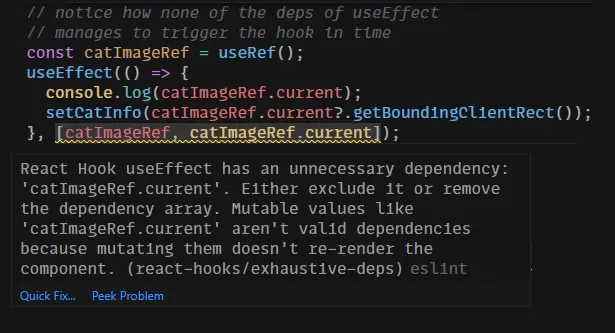原文:useCallback Might Be What You Meant By useRef & useEffect
在React中,useRef和useEffect是常用的钩子函数,用于不同的目的。
useRef通常用于保存在组件渲染之间持久存在的可变值,而useEffect用于执行诸如数据获取、订阅或DOM操作等副作用。
然而,当涉及对React元素挂载做出响应时,有一个更好的选择:useCallback。
尝试在Effect中使用Ref
如果你想要对React元素在DOM中的挂载做出响应,你可能会尝试使用useRef来获取它的引用,并使用useEffect来响应其挂载和卸载。但这样做是无效的。

这是因为当组件被(卸载)挂载并通过useRef连接到ref.current时,ref.current的更改并没有触发回调或重新渲染,自然也不会触发预期的生命周期回调。
甚至react-hooks 的ESLint规则也会对此发出警告。请注意,无论是ref还是ref.current作为useEffect的依赖项,都不会触发它的执行(这是useRef的特性决定的)。
下面的例子展示了上面的方法确实不可行的(在Code Sandbox中尝试)。
export default function App() {
const [count, setCount] = useState(1);
const shouldShowImageOfCat = count % 3 === 0;
const [catInfo, setCatInfo] = useState(false);
// notice how none of the deps of useEffect
// manages to trigger the hook in time
const catImageRef = useRef();
useEffect(() => {
console.log(catImageRef.current);
setCatInfo(catImageRef.current?.getBoundingClientRect());
// notice the warning below
}, [catImageRef, catImageRef.current]);
return (
<div className="App">
<h1>useEffect & useRef vs useCallback</h1>
<p>
An image of a cat would appear on every 3rd render.
<br />
<br />
Would our hook be able to make the emoji see it?
<br />
<br />
{catInfo ? "😂" : "😩"} - I {catInfo ? "" : "don't"} see the cat 🐈
{catInfo ? `, it's height is ${catInfo.height}` : ""}!
</p>
<input disabled value={`render #${count}`} />
<button onClick={() => setCount((c) => c + 1)}>next render</button>
<br />
{shouldShowImageOfCat ? (
<img
ref={catImageRef}
src={catImageUrl}
alt="cat"
width="50%"
style={{ padding: 10 }}
/>
) : (
""
)}
</div>
);
}那我们应该怎么做呢?使用useCallback。(参考react官方文档)
使用useCallback替代Ref
我们可以依赖于将一个普通函数通过useCallback包装后传递给ref,并对它返回的最新DOM节点引用做出反应。
下面的代码是一个例子(在Code Sandbox中尝试):
export default function App() {
const [count, setCount] = useState(1);
const shouldShowImageOfCat = count % 3 === 0;
const [catInfo, setCatInfo] = useState(false);
// notice how this is a useCallback
// that's used as the "ref" of the image below
const catImageRef = useCallback((catImageNode) => {
console.log(catImageNode);
setCatInfo(catImageNode?.getBoundingClientRect());
}, []);
return (
<div className="App">
<h1>useEffect & useRef vs useCallback</h1>
<p>
An image of a cat would appear on every 3rd render.
<br />
<br />
Would our hook be able to make the emoji see it?
<br />
<br />
{catInfo ? "😂" : "😩"} - I {catInfo ? "" : "don't"} see the cat 🐈
{catInfo ? `, it's height is ${catInfo.height}` : ""}!
</p>
<input disabled value={`render #${count}`} />
<button onClick={() => setCount((c) => c + 1)}>next render</button>
<br />
{shouldShowImageOfCat ? (
<img
ref={catImageRef}
src={catImageUrl}
alt="cat"
width="50%"
style={{ padding: 10 }}
/>
) : (
""
)}
</div>
);
}
在上面的例子中,我们可以看到useCallback被传入了ref参数中,这个过程中我们需要注意以下两点:
- ref函数保证在元素挂载和卸载时被调用,即使是第一次挂载,甚至在父元素卸载导致的情况下也是如此。
- 务必使用*
useCallback*来包装ref回调函数。因为如果没有使用useCallback,在ref回调函数中引发重新渲染,会导致ref回调函数再次以null触发,可能导致无限循环,这是由于React内部机制所致。
其他方案
实际上这种模式可以以多种方式使用,以下三种方法渐进地对Node操作进行了优化:
useState
由于useState是在渲染之间保持一致的函数,它也可以用作ref。在这种情况下,整个节点将保存在state中。
作为一个状态,当它发生变化时,它会触发重新渲染,并且可以安全地在渲染结果和useEffect的依赖项中使用该状态:
const [node, setRef] = useState(null);
useEffect(() => {
if (!node) {
console.log('unmounted!');
return null;
}
console.log('mounted');
const fn = e => console.log(e);
node.addEventListener('mousedown', fn);
return () => node.removeEventListener('mousedown', fn);
}, [node])useStateRef
访问DOM是一项昂贵的操作,因此我们希望尽可能少地进行这样的操作。
如果你不需要像之前的钩子函数中那样保存整个节点,最好只在一个状态中保存其中的一部分:
// the hook
function useStateRef(processNode) {
const [node, setNode] = useState(null);
const setRef = useCallback(newNode => {
setNode(processNode(newNode));
}, [processNode]);
return [node, setRef];
}
// how it's used
const [clientHeight, setRef] = useStateRef(node => (node?.clientHeight || 0));
useEffect(() => {
console.log(`the new clientHeight is: ${clientHeight}`);
}, [clientHeight])
// <div ref={setRef}....
// <div>the current height is: {clientHeight}</div>useRefWithCallback
然而,有时为了性能考虑,你可以在使用ref的元素挂载和卸载时避免触发重新渲染。
下面的钩子函数不会将节点保存在状态中。它直接响应挂载和卸载,因此不会触发任何重新渲染。
// the hook
function useRefWithCallback(onMount, onUnmount) {
const nodeRef = useRef(null);
const setRef = useCallback(node => {
if (nodeRef.current) {
onUnmount(nodeRef.current);
}
nodeRef.current = node;
if (nodeRef.current) {
onMount(nodeRef.current);
}
}, [onMount, onUnmount]);
return setRef;
}
const onMouseDown = useCallback(e => console.log('hi!', e.target.clientHeight), []);
const setDivRef = useRefWithCallback(
node => node.addEventListener("mousedown", onMouseDown),
node => node.removeEventListener("mousedown", onMouseDown)
);
// <div ref={setDivRef}
在上面这个例子中,setRef函数被传入了ref中,只有在DOM节点发生变化时才会调用它来更新ref,借此实现了生命周期函数。
- 若调用时ref中已经有值,则说明组件出现了变化,先用调用上一个组件的
unmount周期,再更新ref,调用其mount周期 - 若调用时ref为
null,则直接更新ref并调用其mount周期即可
最终,如果你理解了将useCallback用作元素ref的原理,你可能会根据自己的特定需求提出自己的想法。
补:在ref中使用useCallback的原理
官方文档:使用ref回调 - react.dev
众所周知,ref并非普通的props,直观地看就是我们无法从props中直接解构出ref。甚至在React.createElement中,ref参数早早地就被抽离了出来。
虽然useRef被我们当作存储视图无关变量的一般方法,但ref 本身作为props传递时却有些许不同,它可以接收三种类型的参数:
- string ref:不推荐,已弃用
- callback ref:将一个函数传给ref,称为回调函数,这个函数的签名为
(ref) ⇒ void - object ref:接收一个
ref对象
这三种类型的ref具有统一的更新时机:在组件的layout阶段(或者说加载完成)时调用或赋值自己的ref参数。
